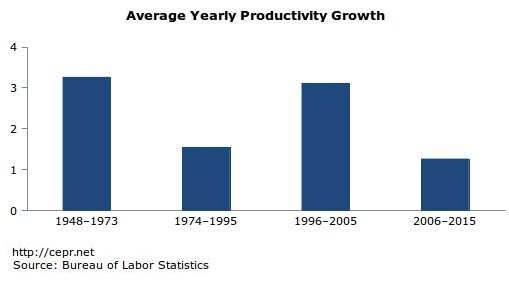December 15, 2016
A common story is that rapid automation is taking away jobs. If humans were being replaced by robots and machines, we would be seeing rapid productivity growth. Since automation generally replaces low-skill jobs, the impact on productivity growth would be significant.
However, if we look the average productivity growth in the past 10 years, the data show we are actually in a period of slow growth.
 The figure above shows the average yearly productivity growth for 4 periods in the post Word War II era. Between 1948 and 1973, productivity growth averaged 3.3 percent a year. This was followed by a period of slow growth between 1974 and 1995, when growth averaged only 1.5 percent per year. Productivity increased at a rapid pace again from 1996 until 2005, when it picked up at an average rate of 3.1 percent per year. The current period, starting in 2006, records the lowest productivity growth since 1948, at an average rate of only 1.3 percent per year.
The figure above shows the average yearly productivity growth for 4 periods in the post Word War II era. Between 1948 and 1973, productivity growth averaged 3.3 percent a year. This was followed by a period of slow growth between 1974 and 1995, when growth averaged only 1.5 percent per year. Productivity increased at a rapid pace again from 1996 until 2005, when it picked up at an average rate of 3.1 percent per year. The current period, starting in 2006, records the lowest productivity growth since 1948, at an average rate of only 1.3 percent per year.
Given that productivity growth is at its lowest post-war level, the story that automation is a large threat looming over the job market is not supported by the data.






